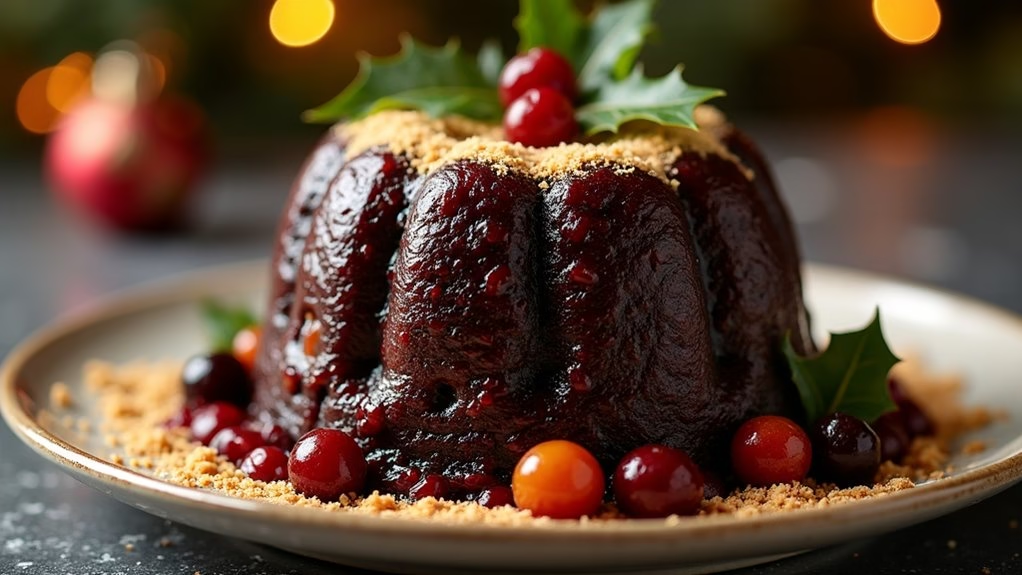The holiday season is upon us, and if you’re new to hosting Christmas dinner, I’ve got your back. Hosting can feel daunting, but with the right recipes, you’ll be the star of the kitchen. Think about serving a perfectly roasted turkey or a honey-glazed ham that’s simply delicious. Pair them with sides like creamy mashed potatoes and end the meal with a classic Christmas pudding. Ready to make this holiday unforgettable? Let’s get started!
Classic Roast Turkey
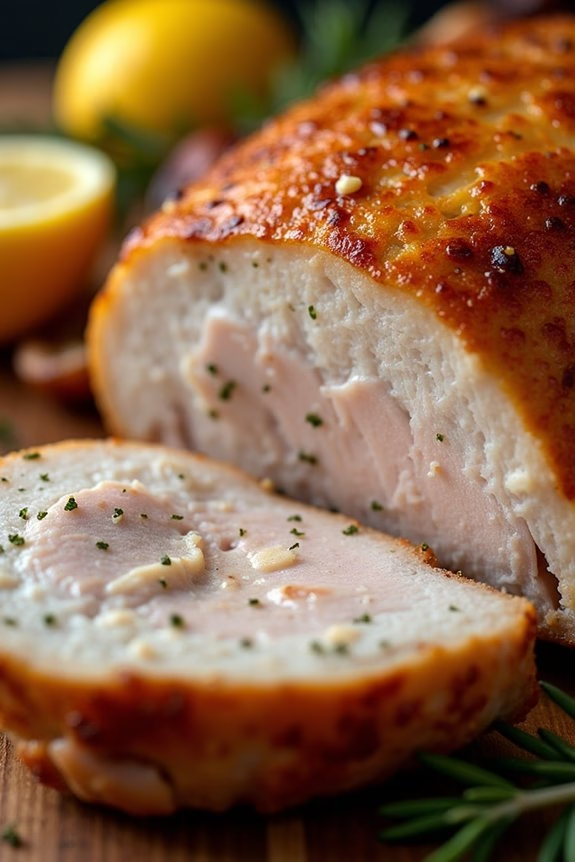
Preparing a classic roast turkey can be an exciting venture, especially for beginners looking to create a memorable Christmas dinner. The key to a perfect roast turkey is to keep it juicy and flavorful, guaranteeing it’s cooked through without drying it out. Selecting the right turkey, preparing it with care, and roasting it to perfection will make your Christmas dinner a delightful experience for everyone at the table.
This recipe will guide you through each step, making certain that even first-time cooks can achieve a festive and impressive centerpiece.
Roasting a turkey involves a few simple steps, but attention to detail is essential. A well-roasted turkey is beautiful to look at, with golden-brown, crispy skin and tender, moist meat inside. It’s important to remember that the process of roasting a turkey includes brining or seasoning, stuffing (if desired), and basting during cooking.
With these steps in mind, let’s start with the ingredients you’ll need to create a classic roast turkey that serves 4-6 people.
Ingredients:
- 1 whole turkey (8-10 pounds)
- 1/2 cup unsalted butter, softened
- 1 tablespoon salt
- 1 teaspoon black pepper
- 1 tablespoon dried thyme
- 1 tablespoon dried rosemary
- 1 lemon, halved
- 1 onion, quartered
- 1 head of garlic, halved crosswise
- 2 cups chicken broth
Cooking Instructions:
- Preheat and Prepare: Preheat your oven to 325°F (165°C). Rinse the turkey inside and out under cold running water and pat it dry with paper towels. Make sure to remove the giblets from the cavity.
- Season the Turkey: In a small bowl, mix together the softened butter, salt, pepper, thyme, and rosemary. Gently loosen the skin of the turkey breast with your fingers and rub some of the butter mixture under the skin. Rub the remaining butter mixture all over the outside of the turkey.
- Stuff the Turkey: Place the lemon halves, onion quarters, and garlic halves inside the cavity of the turkey. These aromatics will infuse the turkey with flavor as it roasts.
- Truss the Turkey: Tie the legs of the turkey together with kitchen twine and tuck the wings under the body to guarantee even cooking.
- Roast the Turkey: Place the turkey on a rack in a large roasting pan. Pour the chicken broth into the bottom of the pan to keep the turkey moist. Roast the turkey in the preheated oven for about 3 to 3 1/2 hours, or until the internal temperature reaches 165°F (74°C) when checked with a meat thermometer inserted into the thickest part of the thigh, without touching the bone. Baste the turkey with the pan juices every 30-40 minutes.
- Rest the Turkey: Once the turkey is done, remove it from the oven and tent it loosely with aluminum foil. Let it rest for at least 20-30 minutes before carving. This resting period allows the juices to redistribute throughout the meat, making it more tender and juicy.
Extra Tips:
For a crispier skin, you can turn up the oven temperature to 425°F (220°C) for the final 30 minutes of roasting. If the turkey browns too quickly, cover it with a piece of foil to prevent burning.
Always verify your turkey is completely thawed before roasting; this can take several days in the refrigerator, depending on its size. If you want to add extra flavor, consider brining the turkey overnight in a saltwater solution with herbs and spices.
Finally, let your turkey rest after roasting to make certain the juices are sealed in, guaranteeing a moist and flavorful result.
Honey Glazed Ham
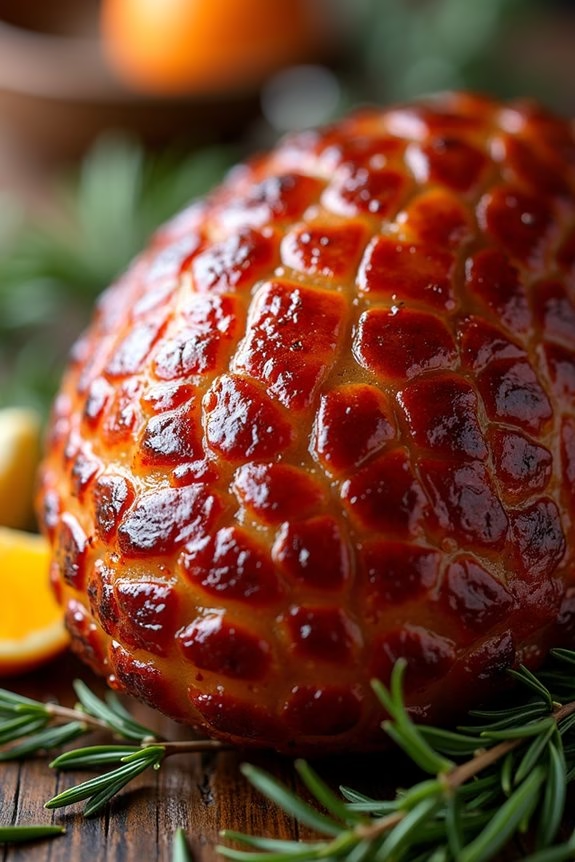
Preparing a delightful Christmas dinner can be intimidating, especially if you’re a beginner in the kitchen. However, with a straightforward dish like Honey Glazed Ham, you can impress your guests without breaking a sweat. This recipe offers a perfect balance of sweetness and savory flavors, making it a festive favorite that’s surprisingly easy to master. The ham is slow-cooked to perfection, marinated in a luscious honey glaze that caramelizes beautifully in the oven. It’s a dish that not only looks impressive as a centerpiece but also fills your home with the comforting scents of the holiday season.
When choosing the perfect ham, opt for a pre-cooked or partially cooked bone-in variety, which helps retain moisture and enhances the flavor. This Honey Glazed Ham serves 4-6 people, making it an ideal choice for a small family gathering or an intimate dinner with friends. Follow this recipe, and you’ll find that creating a show-stopping holiday meal isn’t only achievable but also incredibly rewarding.
Ingredients:
- 1 bone-in half ham, pre-cooked or partially cooked (about 4-5 pounds)
- 1 cup honey
- 1/2 cup brown sugar
- 1/4 cup Dijon mustard
- 1/4 cup apple cider vinegar
- 1/2 teaspoon ground cinnamon
- 1/4 teaspoon ground cloves
- 1/4 teaspoon ground nutmeg
- 1/4 teaspoon ground ginger
- 1/4 teaspoon black pepper
Cooking Instructions:
- Preheat the Oven: Start by preheating your oven to 325°F (165°C). This guarantees that the ham heats evenly and the glaze caramelizes beautifully.
- Prepare the Ham: Place the ham in a large roasting pan, flat side down. Score the surface of the ham in a crisscross pattern with a sharp knife, cutting about 1/4 inch deep. This helps the glaze to penetrate and flavor the meat.
- Make the Glaze: In a medium saucepan, combine the honey, brown sugar, Dijon mustard, apple cider vinegar, cinnamon, cloves, nutmeg, ginger, and black pepper. Stir the mixture over medium heat until the sugar is dissolved and the ingredients are well combined. Allow it to simmer for about 5 minutes, then remove from heat.
- Apply the Glaze: Brush about half of the glaze over the ham, making sure it gets into the scored cuts. Cover the ham loosely with aluminum foil to prevent it from drying out.
- Bake the Ham: Place the ham in the preheated oven and bake for approximately 1.5 to 2 hours, or until the internal temperature reaches 140°F (60°C). Baste the ham every 30 minutes with the remaining glaze.
- Finish and Serve: Remove the foil for the last 15 minutes of cooking to allow the glaze to caramelize. Once done, take the ham out of the oven and let it rest for about 10 minutes before slicing. This resting period allows the juices to redistribute, keeping the meat moist.
Extra Tips:
When preparing Honey Glazed Ham, it’s important to monitor the glaze closely as it can burn due to the high sugar content. Adjust your oven’s heat if necessary, or cover the ham more tightly with foil.
For added flavor, consider studding the ham with cloves before glazing, which will infuse the meat with a warm, aromatic note. Always use a meat thermometer to confirm your ham is perfectly cooked, avoiding the risk of under or overcooking.
Finally, remember that leftovers make excellent sandwiches or can be diced and added to soups and salads, making sure nothing goes to waste.
Garlic Herb Prime Rib
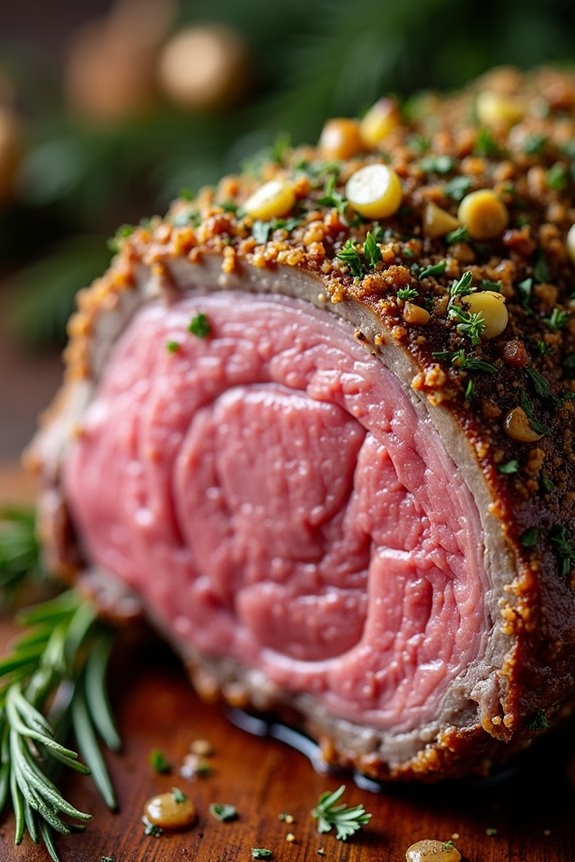
Garlic Herb Prime Rib is a classic holiday dish that brings a touch of elegance and flavor to your Christmas dinner. This recipe is perfect for beginners who want to impress their guests with a tender, juicy, and flavorful prime rib. The key to a successful prime rib is using fresh herbs and garlic to create a rich and aromatic crust that enhances the natural flavors of the beef.
With a few simple steps, you can prepare a prime rib that will be the centerpiece of your festive meal. To achieve the perfect Garlic Herb Prime Rib, it’s vital to start with a high-quality cut of meat. This dish relies on the marbling and natural juices of the rib roast to deliver a succulent result.
The garlic and herb mixture infuses the meat with a delightful aroma and taste, while the roasting process guarantees a tender and juicy interior. Whether you’re hosting a small family gathering or a larger celebration, this Garlic Herb Prime Rib is sure to be a hit at your Christmas dinner table.
Ingredients for 4-6 servings:
- 1 (4-6 pound) bone-in prime rib roast
- 6 cloves of garlic, minced
- 1/4 cup fresh rosemary, chopped
- 1/4 cup fresh thyme, chopped
- 1/4 cup olive oil
- 2 tablespoons kosher salt
- 1 tablespoon black pepper
- 1 tablespoon Dijon mustard
Cooking Instructions:
- Preparation of the Prime Rib: Begin by removing the prime rib from the refrigerator and allowing it to sit at room temperature for about 2 hours before cooking. This guarantees even cooking throughout the roast.
- Preheat the Oven: Set your oven to 450°F (232°C) and allow it to fully preheat. A hot oven is vital for creating a crispy crust on the prime rib.
- Prepare the Herb Mixture: In a small bowl, combine the minced garlic, chopped rosemary, chopped thyme, olive oil, Dijon mustard, kosher salt, and black pepper. Mix well to form a paste.
- Season the Prime Rib: Pat the prime rib dry with paper towels. Rub the garlic herb paste evenly all over the surface of the roast, making sure that it’s well coated.
- Roasting: Place the seasoned prime rib in a roasting pan with the bone side down. Insert a meat thermometer into the thickest part of the roast, being careful that it doesn’t touch bone. Roast in the preheated oven for 20 minutes at 450°F to sear the outside.
- Adjust the Temperature: After the initial sear, reduce the oven temperature to 325°F (163°C). Continue roasting until the internal temperature reaches your desired level of doneness: 120°F for rare, 130°F for medium-rare, or 140°F for medium. This will take approximately 1.5 to 2 hours.
- Rest the Meat: Once the prime rib reaches the desired temperature, remove it from the oven and tent it loosely with aluminum foil. Allow it to rest for 20-30 minutes before carving. This step is vital for allowing the juices to redistribute, resulting in a juicy roast.
- Carve and Serve: Slice the prime rib into thick slices and serve with your favorite holiday sides.
Extra Tips:
For the best results, always use a meat thermometer to guarantee accurate cooking temperatures. Remember, the prime rib will continue to cook slightly after being removed from the oven, so it’s best to take it out at least 5-10 degrees below your target doneness.
If possible, use fresh herbs instead of dried ones for a more vibrant flavor. Finally, don’t skip the resting period, as it greatly enhances the tenderness and juiciness of the prime rib.
Cranberry Orange Sauce
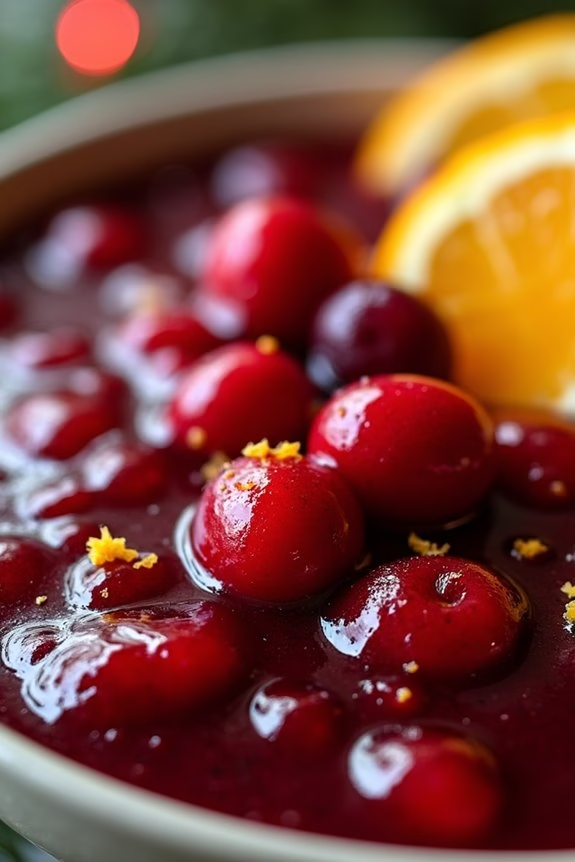
Cranberry Orange Sauce is a vibrant and tangy addition to your Christmas dinner spread, bringing a burst of color and flavor that complements a variety of dishes. This simple yet delicious recipe is perfect for beginners looking to impress their guests with a homemade touch. The combination of tart cranberries and sweet, citrusy oranges creates a harmonious balance that enhances the natural flavors of your main course, whether it be turkey, ham, or a plant-based alternative.
This recipe is designed to serve 4-6 people, making it an ideal choice for small to medium gatherings. With just a handful of ingredients and straightforward cooking instructions, you’ll have a delightful sauce that can be prepared in advance, giving you more time to focus on other elements of your festive meal.
Plus, the vibrant red color of the sauce adds a beautiful visual element to your dining table, embodying the spirit of the holiday season.
Ingredients:
- 12 ounces (about 3 cups) fresh or frozen cranberries
- 1 cup freshly squeezed orange juice
- 1 tablespoon orange zest
- 1 cup granulated sugar
- 1/2 cup water
- 1/4 teaspoon ground cinnamon (optional)
Cooking Instructions:
- Prepare the Ingredients: Start by rinsing the cranberries under cold water and discarding any that are soft or damaged. If using fresh oranges, zest one orange first and then juice enough to get one cup of orange juice.
- Combine the Ingredients: In a medium-sized saucepan, combine the cranberries, orange juice, orange zest, granulated sugar, and water. If you like a hint of spice, add the ground cinnamon to the mixture.
- Cook the Sauce: Place the saucepan over medium-high heat and bring the mixture to a gentle boil. Stir occasionally to help dissolve the sugar and prevent sticking.
- Simmer and Thicken: Once boiling, reduce the heat to low and let the sauce simmer for about 10-15 minutes. Stir occasionally. The cranberries will start to burst, and the mixture will thicken as it cooks.
- Check Consistency: After 15 minutes, the sauce should be thickened to your liking. If you prefer a smoother sauce, you can mash the cranberries with the back of a spoon or use a hand blender for a smoother texture.
- Cool and Serve: Remove the saucepan from the heat and let the cranberry orange sauce cool to room temperature. It will continue to thicken as it cools. Serve the sauce in a bowl alongside your main dish or refrigerate it for later use.
Extra Tips:
When preparing Cranberry Orange Sauce, keep in mind that it can be made a day or two in advance and stored in the refrigerator, allowing the flavors to meld and deepen.
If you’re using frozen cranberries, there’s no need to thaw them before cooking, as they’ll cook down well from frozen. For an added depth of flavor, consider adding a splash of vanilla extract or a pinch of nutmeg.
This sauce also makes a wonderful topping for desserts like cheesecake or ice cream, making it a versatile addition to your holiday cooking repertoire.
Creamy Mashed Potatoes
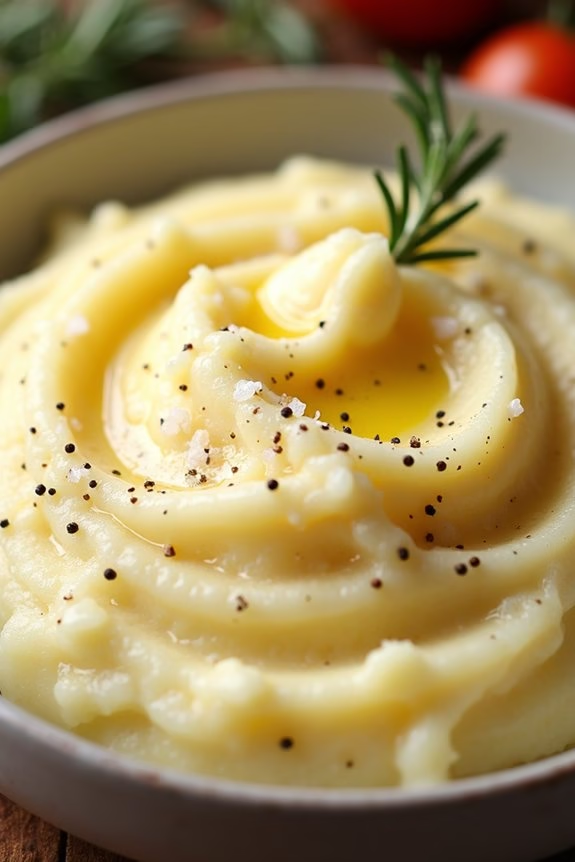
Creamy Mashed Potatoes are a classic side dish that’s perfect for Christmas dinner. They provide a smooth, rich, and buttery flavor that complements any main course, making them an essential part of the holiday meal. Made with simple ingredients, these mashed potatoes are easy to prepare and guaranteed to delight your guests with their silky texture and comforting taste.
For beginners, mastering the art of creating the perfect mashed potatoes can elevate your culinary skills and impress your family and friends. This recipe is designed to be straightforward, guiding you through the process to achieve the ideal consistency and flavor. With just a few steps, you can create a dish that’s both satisfying and indulgent, providing a wonderful accompaniment to any festive feast.
Ingredients (Serves 4-6)
- 2 pounds of Yukon Gold potatoes, peeled and cut into chunks
- 1/2 cup of unsalted butter
- 1 cup of heavy cream
- Salt to taste
- Freshly ground black pepper to taste
- Optional: 2 cloves of garlic, minced
Instructions
- Prepare the Potatoes: Start by peeling and cutting the potatoes into uniform chunks. This guarantees they cook evenly. Place them in a large pot and cover with cold water by about an inch.
- Boil the Potatoes: Add a pinch of salt to the pot and bring the water to a boil over medium-high heat. Once boiling, reduce the heat to a simmer and cook for about 15-20 minutes, or until the potatoes are easily pierced with a fork.
- Drain the Potatoes: Once the potatoes are tender, drain them thoroughly in a colander. Confirm there’s no excess water left, as this will affect the texture of your mashed potatoes.
- Heat the Butter and Cream: In the same pot, melt the butter over low heat. If you’re using garlic, add it now and sauté for about 1 minute until fragrant. Then, stir in the heavy cream and warm it gently.
- Mash the Potatoes: Return the drained potatoes to the pot. Using a potato masher or a ricer, mash the potatoes until smooth. Gradually incorporate the butter and cream mixture, stirring continuously until you reach your desired creamy consistency.
- Season and Serve: Season the mashed potatoes with salt and freshly ground black pepper to taste. Mix well to guarantee even seasoning. Serve immediately while hot for the best flavor and texture.
Extra Tips
For ultimate creaminess, use a potato ricer instead of a masher to achieve a smoother texture. If you want to add extra flavor, consider infusing the cream with herbs such as thyme or rosemary while heating it, then strain them out before mixing with the potatoes.
Additionally, be careful not to overmix the potatoes, as this can lead to a gluey texture. Reheat any leftovers gently on the stovetop with a splash of milk or cream to restore their creamy consistency.
Sage and Sausage Stuffing
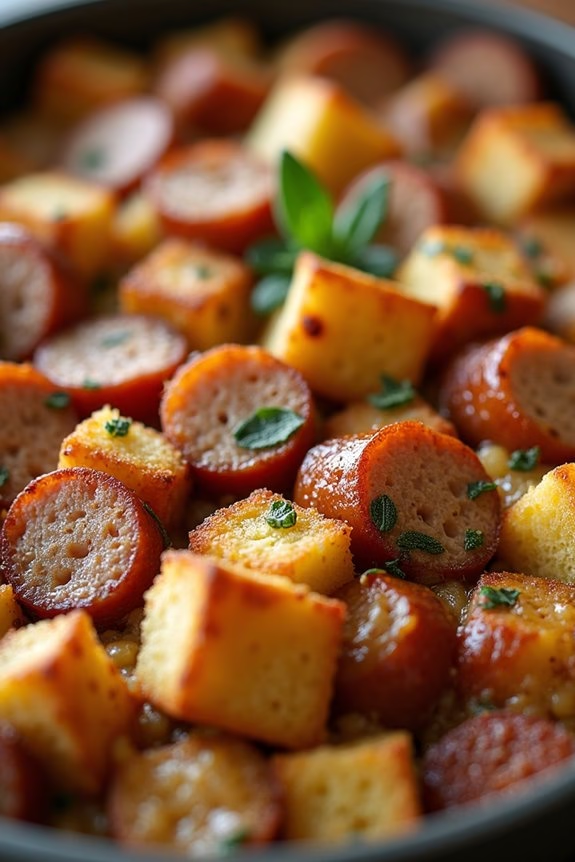
If you’re looking to add a touch of tradition to your Christmas dinner, Sage and Sausage Stuffing is a perfect choice. This classic dish combines the savory flavors of sausage with the aromatic notes of sage, creating a comforting and hearty side dish that pairs beautifully with turkey or any roast.
It’s an ideal recipe for beginners because it’s straightforward to prepare, yet it delivers a delicious complexity in flavor that will impress your guests. This stuffing recipe is designed to serve 4-6 people, making it a great addition to your holiday spread.
With its crispy top and moist interior, this stuffing is sure to become a family favorite. The key to success is using good quality sausage and fresh sage to enhance the dish’s overall taste. Follow the steps below to create a stuffing that’s both simple and satisfying.
Ingredients (Serves 4-6):
- 1 loaf of day-old bread, cut into 1-inch cubes
- 1 pound of pork sausage
- 1 medium onion, finely chopped
- 2 celery stalks, diced
- 1/2 cup unsalted butter
- 2 tablespoons fresh sage, chopped
- 1 teaspoon dried thyme
- 1/2 teaspoon salt
- 1/4 teaspoon black pepper
- 2 cups chicken or vegetable broth
- 2 eggs, beaten
Cooking Instructions:
- Prepare the Bread: Preheat your oven to 250°F (120°C). Spread the bread cubes on a baking sheet and bake them for about 30 minutes, or until they’re dry and slightly toasted. Remove from the oven and set aside to cool.
- Cook the Sausage: In a large skillet over medium heat, cook the sausage, breaking it up with a spoon, until it’s browned and cooked through. Remove the sausage from the skillet and drain any excess fat on a paper towel-lined plate.
- Sauté Vegetables: In the same skillet, melt the butter over medium heat. Add the onion and celery, and cook until they’re soft and translucent, about 5-7 minutes. Stir in the fresh sage, dried thyme, salt, and pepper, and cook for an additional minute to release the flavors.
- Combine Ingredients: In a large mixing bowl, combine the toasted bread cubes, cooked sausage, and sautéed vegetables. Mix them well to guarantee even distribution of ingredients.
- Moisten the Mixture: In a separate bowl, whisk together the chicken or vegetable broth with the beaten eggs. Pour this liquid mixture over the bread and sausage mixture, and gently stir until the bread is evenly moistened.
- Bake the Stuffing: Preheat your oven to 350°F (175°C). Transfer the stuffing mixture into a greased baking dish. Cover the dish with aluminum foil and bake for 30 minutes. Then, remove the foil and bake for an additional 15 minutes, or until the top is golden brown and crispy.
Extra Tips:
When making Sage and Sausage Stuffing, you can customize the recipe by adding extras like dried cranberries, chopped apples, or toasted nuts for additional texture and flavor.
Remember to taste the mixture before baking to adjust the seasoning as needed. If you prefer a softer stuffing, add a bit more broth to achieve your desired consistency.
Finally, if you’re preparing this dish ahead of time, you can assemble the stuffing and store it in the refrigerator for up to a day before baking. This makes it convenient and ready to pop into the oven while you focus on other holiday preparations.
Roasted Brussels Sprouts With Bacon
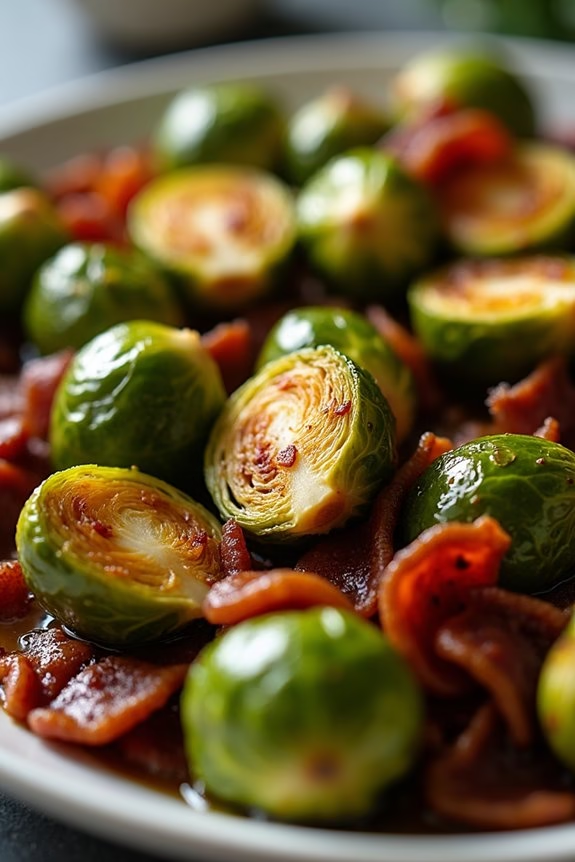
Roasted Brussels Sprouts With Bacon is an excellent side dish for a Christmas dinner, especially for beginners looking to impress their guests with a simple yet delicious recipe. The combination of the earthy Brussels sprouts with the savory, crispy bacon creates a delightful contrast in flavors and textures.
This dish not only adds vibrant green color to your holiday table, but also provides a nutritious option that everyone will enjoy. Ideal for serving 4-6 people, this recipe is straightforward and requires minimal ingredients, making it perfect for those new to cooking Christmas dinners.
With just a few steps, you can create a dish that complements any main course, from turkey to ham. The aroma of roasted Brussels sprouts combined with smoky bacon will fill your kitchen, creating a welcoming atmosphere for your guests.
Ingredients:
- 1 ½ pounds Brussels sprouts, trimmed and halved
- 5 strips of bacon, chopped
- 3 tablespoons olive oil
- Salt, to taste
- Freshly ground black pepper, to taste
- 2 tablespoons balsamic vinegar (optional)
Instructions:
- Preheat the Oven: Begin by preheating your oven to 400°F (200°C). This will guarantee that the Brussels sprouts roast evenly and achieve a nice, crispy texture.
- Prepare the Brussels Sprouts: Trim the ends of the Brussels sprouts and remove any yellow or damaged outer leaves. Cut each sprout in half to guarantee even cooking.
- Combine Ingredients: In a large bowl, toss the halved Brussels sprouts with olive oil, salt, and pepper until they’re well-coated. Add the chopped bacon and mix everything together.
- Arrange on Baking Sheet: Spread the Brussels sprouts and bacon mixture in a single layer on a large baking sheet. Make sure the Brussels sprouts are cut side down for maximum caramelization.
- Roast in the Oven: Place the baking sheet in the preheated oven and roast for 20-25 minutes. Stir the sprouts halfway through the cooking time to guarantee even browning. They’re done when the Brussels sprouts are tender and the bacon is crispy.
- Add Balsamic Vinegar (Optional): If desired, drizzle the roasted Brussels sprouts with balsamic vinegar immediately after removing them from the oven. Toss to coat evenly.
- Serve: Transfer the roasted Brussels sprouts with bacon to a serving dish and serve hot.
Extra Tips: To guarantee your Brussels sprouts cook evenly, try to select sprouts of similar sizes. If some are considerably larger, cut them into quarters instead of halves.
You can also experiment with additional seasonings such as garlic powder or Parmesan cheese to enhance the flavor. If you prefer a sweeter touch, add a sprinkle of brown sugar or a drizzle of maple syrup before roasting.
Sweet Potato Casserole
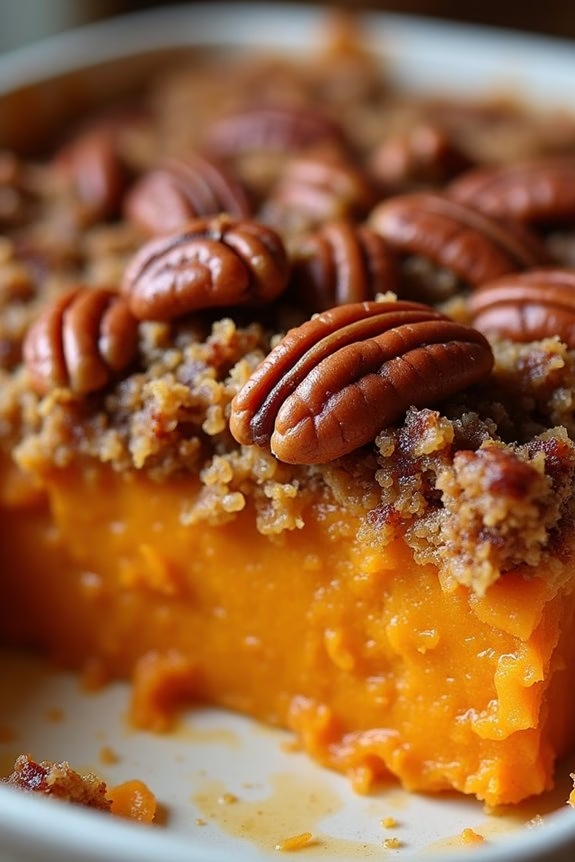
The Sweet Potato Casserole is a delightful and warming dish that’s perfect for a Christmas dinner. The creamy sweetness of the mashed sweet potatoes, combined with a crunchy pecan topping, creates a dish that’s both comforting and festive. This recipe is simple enough for beginners but will surely impress your guests with its rich flavors and textures.
Whether you’re hosting a big family gathering or a small cozy dinner, this casserole will be a hit at your holiday table. This dish serves 4-6 people and is ideal as a side dish for your Christmas meal. The sweet potatoes are first cooked and mashed with butter, sugar, and spices to create a smooth and flavorful base.
It’s then topped with a crunchy mixture of pecans, brown sugar, and butter, which adds a delightful contrast to the creamy potatoes. The casserole is baked until golden brown, allowing the flavors to meld together beautifully. Follow this simple recipe to create a Sweet Potato Casserole that your family and friends will love.
Ingredients:
- 4 cups sweet potatoes, peeled and cubed
- 1/2 cup granulated sugar
- 2 large eggs, beaten
- 1/2 cup butter, melted
- 1 teaspoon vanilla extract
- 1/2 cup milk
- 1/4 teaspoon salt
Topping:
- 1/2 cup packed brown sugar
- 1/3 cup all-purpose flour
- 1/3 cup butter, melted
- 1 cup chopped pecans
Instructions:
- Preheat Oven: Preheat your oven to 350°F (175°C) to verify it’s ready for baking once the casserole is prepared.
- Cook Sweet Potatoes: Place the cubed sweet potatoes in a large pot and cover them with water. Bring to a boil over medium-high heat and cook until tender, about 15-20 minutes. Drain and allow them to cool slightly.
- Mash Sweet Potatoes: Transfer the cooked sweet potatoes to a large mixing bowl. Use a potato masher or fork to mash them until smooth.
- Mix Base Ingredients: Add the granulated sugar, beaten eggs, melted butter, vanilla extract, milk, and salt to the mashed sweet potatoes. Mix until well combined and smooth.
- Prepare Topping: In a separate small bowl, combine the brown sugar, flour, melted butter, and chopped pecans. Mix well until the ingredients form a crumbly mixture.
- Assemble Casserole: Pour the sweet potato mixture into a greased 9×13 inch baking dish, spreading it evenly. Sprinkle the pecan topping evenly over the sweet potato mixture.
- Bake: Bake in the preheated oven for 30-35 minutes, or until the topping is golden brown and crispy. Allow the casserole to cool for a few minutes before serving.
Extra Tips:
For an even richer flavor, consider adding a pinch of cinnamon or nutmeg to the sweet potato mixture. If you prefer a less sweet casserole, you can reduce the amount of sugar in the sweet potato base.
To save time on the day of your Christmas dinner, you can prepare the sweet potato mixture and topping separately a day in advance and store them in the refrigerator. When you’re ready to bake, simply assemble the casserole and pop it in the oven. Enjoy your delicious and comforting Sweet Potato Casserole with family and friends!
Green Bean Almondine
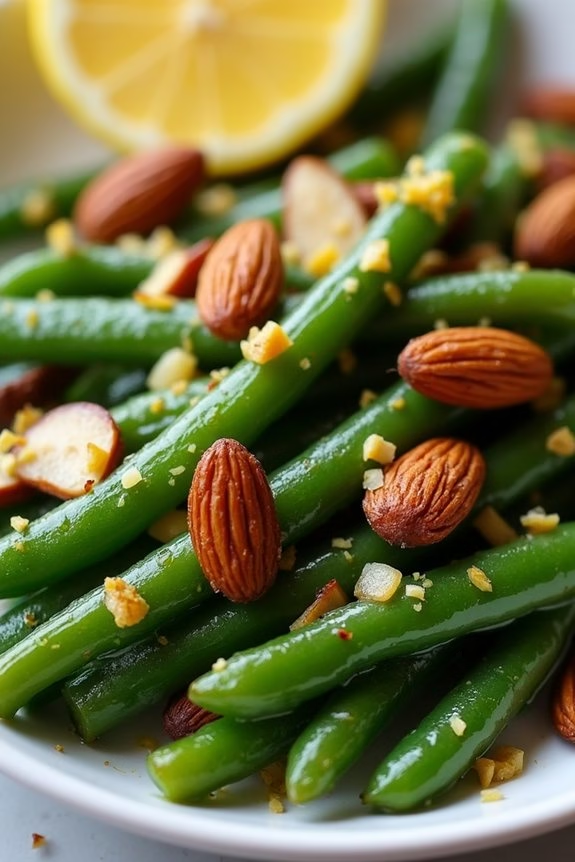
Green Bean Almondine is a classic and elegant side dish that pairs perfectly with any Christmas dinner. This French-inspired dish is known for its simplicity and delightful flavor, featuring tender green beans tossed with buttery, toasted almonds and a hint of lemon. It’s a great choice for beginners looking to add a touch of sophistication to their holiday meal without the stress of complicated preparation.
The combination of fresh green beans and crunchy almonds creates a delicious contrast in texture that will impress your guests. This recipe serves 4 to 6 people and is both quick and easy to prepare. The key to mastering Green Bean Almondine lies in balancing the flavors and textures. By using fresh ingredients and following these straightforward steps, you’ll create a dish that isn’t only visually appealing but also a treat for the taste buds.
Whether you’re hosting a large gathering or an intimate dinner, this dish will surely become a favorite on your Christmas table.
Ingredients:
- 1 pound fresh green beans, trimmed
- 3 tablespoons unsalted butter
- 1/3 cup sliced almonds
- 2 cloves garlic, minced
- 1 tablespoon lemon juice
- Salt and pepper to taste
- Lemon zest (optional) for garnish
Cooking Instructions:
- Prepare the Green Beans: Start by trimming the ends of the green beans. Bring a large pot of salted water to a boil and add the green beans. Cook for 4-5 minutes until the beans are tender but still crisp. Drain the beans and immediately plunge them into a bowl of ice water to stop the cooking process and preserve their bright green color.
- Toast the Almonds: In a large skillet, melt the butter over medium heat. Add the sliced almonds and cook, stirring frequently, until they’re golden brown and fragrant, about 3-4 minutes. Be careful not to burn them.
- Sauté the Garlic: Add the minced garlic to the skillet with the toasted almonds. Cook for about 1 minute, stirring constantly to prevent burning, until the garlic is fragrant.
- Combine Ingredients: Drain the green beans from the ice water and add them to the skillet. Toss the beans with the almonds and garlic, ensuring they’re evenly coated with the butter.
- Season and Finish: Add the lemon juice to the skillet and season with salt and pepper to taste. Toss everything together for another minute until the beans are heated through. If desired, garnish with lemon zest for an extra burst of flavor.
Extra Tips:
When making Green Bean Almondine, it’s crucial to keep an eye on the almonds while toasting to prevent them from burning, as they can go from perfectly toasted to burnt very quickly.
For a more robust flavor, you can use brown butter instead of regular butter. Additionally, feel free to experiment by adding a pinch of red pepper flakes for a hint of heat or a sprinkle of fresh herbs like parsley for extra freshness.
Yorkshire Pudding
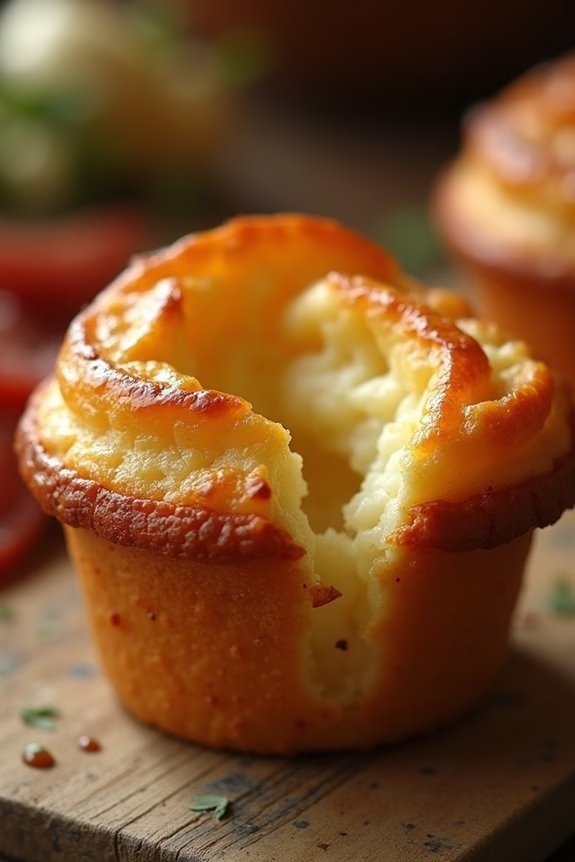
Yorkshire Pudding is a classic British side dish that’s perfect for a Christmas dinner. Known for its crispy exterior and soft, airy interior, it pairs wonderfully with a succulent roast and rich gravy.
Despite its fancy reputation, Yorkshire Pudding is surprisingly simple to make, requiring minimal ingredients and a straightforward process. This recipe will guide you through making the perfect Yorkshire Pudding, making certain that your Christmas dinner is both traditional and delightful.
Whether you’re new to cooking or an experienced chef looking to perfect this classic dish, this recipe will provide you with all the necessary steps to create a delicious Yorkshire Pudding for 4-6 people.
With the right ingredients and a bit of patience, you’ll be able to impress your family and friends with your culinary skills this holiday season. So, let’s explore the ingredients and instructions to bring this British favorite to your Christmas table.
Ingredients (for 4-6 servings):
- 1 cup all-purpose flour
- 1 cup whole milk
- 3 large eggs
- 1/2 teaspoon salt
- 1/4 cup vegetable oil or beef drippings
Cooking Instructions:
1. Preheat the Oven: Begin by preheating your oven to 425°F (220°C). It’s vital to have a hot oven for the Yorkshire Pudding to rise properly.
2. Prepare the Batter: In a mixing bowl, whisk together the flour and salt. In a separate bowl, beat the eggs and milk until well combined. Gradually add the wet ingredients to the dry ingredients, whisking continuously until you have a smooth batter.
Let the batter rest for at least 30 minutes to allow the flour to absorb the liquid.
3. Heat the Oil: While the batter is resting, pour the vegetable oil or beef drippings into a 12-cup muffin tin, distributing evenly among the cups.
Place the muffin tin in the preheated oven for about 5 minutes, or until the oil is extremely hot but not smoking.
4. Add the Batter: Carefully remove the hot muffin tin from the oven and quickly pour the batter into the hot oil, filling each cup about halfway.
The hot oil will help the batter rise and create a crispy texture.
5. Bake the Puddings: Return the muffin tin to the oven and bake for 20-25 minutes, or until the puddings have puffed up and are golden brown.
Avoid opening the oven door during baking, as the sudden drop in temperature can cause the puddings to deflate.
6. Serve Immediately: Once baked, remove the Yorkshire Puddings from the oven and Serve Immediately.
They’re best enjoyed fresh and hot from the oven.
Extra Tips:
To achieve the best results, make sure that your batter is smooth and lump-free by whisking vigorously.
Letting the batter rest is significant for the perfect rise, as it allows the gluten to relax.
Using beef drippings instead of vegetable oil can add a rich, savory flavor to the puddings.
Additionally, make sure the oil is hot before adding the batter, as this will help create the signature puff and crispiness.
Finally, it’s important not to open the oven door during baking to maintain a consistent temperature and prevent deflation.
Traditional Christmas Pudding
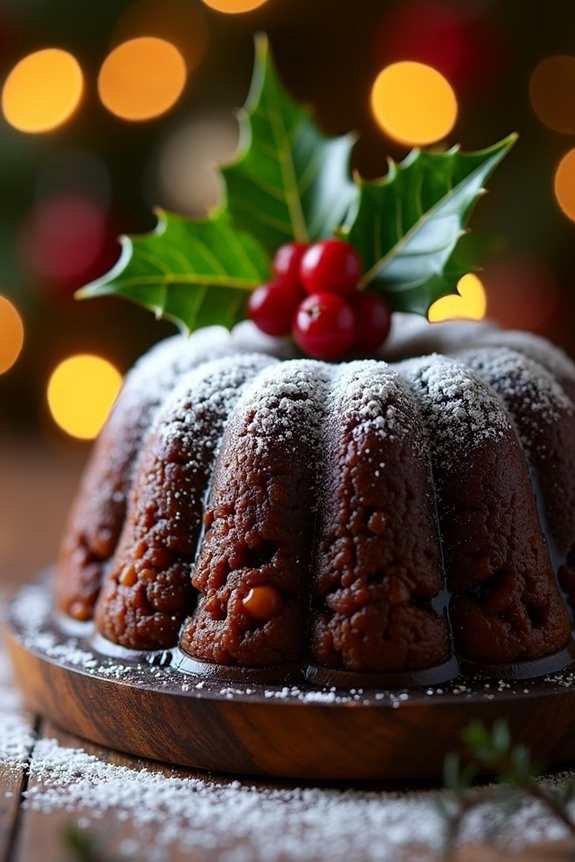
Christmas pudding, also known as plum pudding, is a quintessential part of a traditional Christmas feast. This rich and fruity dessert is steeped in tradition and filled with a delightful mix of dried fruits, spices, and suet, providing a warm and comforting end to a holiday meal.
Despite its deep roots in British culinary history, making a Christmas pudding is quite approachable for beginners, especially when broken down into simple steps.
The key to a successful Christmas pudding lies in its preparation well in advance of the holiday. This dessert is typically made weeks before Christmas to allow the flavors to mature and deepen over time. The rich combination of ingredients, including dried fruits, brandy, and spices, make it a festive treat that captures the essence of the season.
Below is a thorough recipe to create this traditional dessert for a serving size of 4-6 people.
Ingredients:
- 125g suet or unsalted butter
- 125g dark brown sugar
- 150g breadcrumbs
- 150g plain flour
- 1 teaspoon baking powder
- 1 teaspoon mixed spice
- 1 teaspoon ground cinnamon
- 1/4 teaspoon ground nutmeg
- 150g currants
- 150g sultanas
- 150g raisins
- 50g chopped mixed peel
- 50g almonds, chopped
- Zest of 1 lemon
- Zest of 1 orange
- 3 large eggs
- 150ml stout or dark beer
- 75ml brandy or rum
- 1 apple, peeled and grated
Cooking Instructions:
- Prepare the mixture: In a large mixing bowl, combine the suet or butter, brown sugar, breadcrumbs, flour, baking powder, mixed spice, cinnamon, and nutmeg. Mix well until all dry ingredients are evenly distributed.
- Add the fruits and nuts: To the dry mixture, add currants, sultanas, raisins, mixed peel, chopped almonds, lemon zest, and orange zest. Stir thoroughly to ascertain the fruits and nuts are coated with the flour mixture.
- Incorporate the liquids: In a separate bowl, beat the eggs and then mix in the stout and brandy. Pour this liquid mixture into the dry ingredients, along with the grated apple. Stir well until everything is thoroughly combined, guaranteeing there are no dry spots.
- Steam the pudding: Grease a 1.2-liter pudding basin and spoon the mixture into it, pressing down lightly. Cover with a circle of baking paper and then a layer of aluminum foil, securing with string. Place the basin in a large saucepan, adding enough water to come halfway up the side of the basin. Cover the pan with a lid and steam for 5 to 6 hours, checking occasionally to confirm the water doesn’t evaporate.
- Cool and store: Once steamed, remove the pudding from the saucepan and let it cool completely. Replace the baking paper and foil with fresh layers, and store in a cool, dark place until Christmas Day.
- Reheat before serving: On the day of serving, steam the pudding again for about 2 hours to reheat thoroughly. Serve warm with brandy butter, cream, or custard.
Extra Tips:
When making Christmas pudding, it’s important to keep the pudding basin well-sealed to prevent any water from entering during steaming.
Regularly check the water level in the saucepan to confirm it doesn’t boil dry, and top up with boiling water as needed. If you’re making the pudding well in advance, feeding it with additional brandy every couple of weeks will enhance its flavor and moisture.
With these tips in mind, you’ll have a delicious, traditional Christmas pudding that will impress your family and guests.

